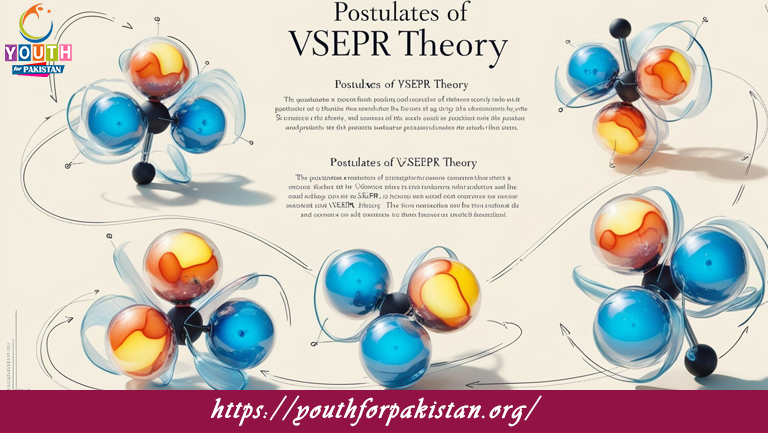Postulates Of VSEPR Theory MDCAT Quiz with Answers

Postulates Of VSEPR Theory MDCAT Quiz: geometry of molecules based on the electron pair repulsion. If these postulates are understood, it would enable the answering of questions in the MDCAT Quiz pertaining to molecular shapes, bond angles, and general structure of the molecules.
H2: Postulates of VSEPR Theory
VSEPR Theory is based on a set of postulates that describe how electron pairs around a central atom determine the shape of a molecule. The key postulates of VSEPR Theory are:
Electron Pairs Repel Each Other In the valence shell of an atom, whether they are bonding pairs or lone pairs, will arrange themselves as far apart as possible to minimize repulsion. This leads to definite molecular geometries depending on the number of electron pairs.
Electron Pairs Occupy Positions in 3D Space: The electron pairs are not confined to a two-dimensional plane but spread out in three-dimensional space. This allows the electron pairs to arrange themselves in specific geometries, such as linear, trigonal planar, or tetrahedral, depending on the number of pairs.
Lone Pairs Take Up More Space: Lone pairs of electrons take up more space than bonding pairs because they are localized around the central atom. This leads to a change in bond angles when lone pairs are present, and quite often, bond angles are less than expected.
Molecular Geometry is Determined by the Number of Electron Pairs: The way bonding and lone pairs are arranged around the central atom is what determines molecular geometry. It is actually the total number of electron pairs—both the bonding and lone pairs—around the central atom that defines the molecular shape. For example, if the molecule has three electron pairs, the shape would be trigonal planar; on the other hand, it will be tetrahedral if it possesses four pairs.
H3: Quiz on VSEPR Postulates
The MCAT Quiz on VSEPR Theory is designed to test a student’s ability in applying the postulates to predict the shape of the molecule. Students will be expected to determine the geometry of molecules based on the number of electron pairs that surround the central atom, and also consider how lone pairs affect bond angles. Questions may include molecules such as ammonia (NH₃), water (H₂O), and carbon dioxide (CO₂), where students are tasked with using the VSEPR postulates to determine the most appropriate molecular geometry. Practicing these types of quiz questions will help students strengthen their understanding related to VSEPR Theory and prepare for MDCAT exam questions.
H2: Application of VSEPR Postulates to Predict Molecular Shapes
In an effort to anticipate the shapes of molecules, a student uses postulates of the VSEPR Theory based on the number of bonding and lone pairs around the central atom. Here’s how the postulates apply to different types of molecular geometries:
Linear Geometry: Occurs when there are two electron pairs around the central atom, resulting in a 180° bond angle. An example is carbon dioxide, CO₂, where the central carbon atom is bonded to two oxygen atoms in a linear arrangement.
Trigonal Planar Geometry: This occurs when there are three electron pairs about the central atom, which give an angle of 120° between the bonds. The example is boron trifluoride (BF₃), where the central boron atom forms three bonds with fluorine atoms.
Tetrahedral Geometry: When there are four electron pairs about the central atom, the bond angles are 109.5°. A classic example is methane (CH₄), where the central carbon atom has four bonds to hydrogen atoms in a tetrahedral arrangement.
Bent or V-Shaped Geometry: Occurs when there are two bonding pairs and one or two lone pairs around the central atom, resulting in bond angles less than 120° or 109.5°. An example is water (H₂O), where the central oxygen atom has two bonding pairs and two lone pairs, resulting in a bent geometry.
H3: Free Flashcard for VSEPR Postulates
To help reinforce their understanding of the VSEPR Theory Postulates, MDCAT students can use the Free Flashcard for this topic. The flashcards provide a quick review of the postulates and how they apply to different molecular geometries. This will help the students, through regular reviewing of the flashcards, understand how electron pairs influence molecular shapes and bond angles. This is perfect for quick revision and ensuring students are well prepared for related questions in the MDCAT exam.

According to VSEPR theory, electron pairs in the valence shell of an atom are arranged to minimize what?

According to VSEPR theory, what happens when there are more lone pairs of electrons around a central atom?

What shape does a molecule with five bonding pairs and no lone pairs adopt according to VSEPR theory?

What happens to the electron pairs around a central atom in a molecule with a square planar geometry?

According to VSEPR theory, how many electron regions are there in a molecule with an octahedral geometry?
Experience the real exam environment with our expertly designed collection of over 25,000 MCQs MDCAT Mock Tests.





